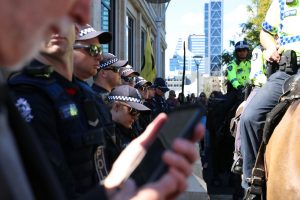How much do Australian governments spend on illicit drug issues?
Australia’s drug policy spending remains heavily skewed toward law enforcement, raising concerns about priorities and effectiveness. According to a 2021/2022 drug budget report by the Drug Policy Modelling Program at UNSW Sydney, Australian governments spent AU$5.45 billion (US$3.63 billion) on illicit drug issues.
Law enforcement consumed the lion’s share with AU$3.5 billion (US$2.3 billion) or 64 percent, followed by treatment with AU$1.5 billion (US$1 billion) or 27 percent, prevention with AU$363 million (US$242 million) or 7 percent, and harm reduction at a mere AU$89 million (US$59.3 million) or 1.6 percent.
Governments do not provide line-item reports of spending on drug policy activities, which means we need to use available data and methods of estimation to calculate relevant funding.
Knowing where money is being spent is important to understand government priorities and for keeping account of policy commitments.
Drug budgets are estimates of governments’ spending on proactive responses to illicit drugs. It is not the remit of drug budgets to identify what governments should spend money on; instead, it is to identify where money is being spent.
Over the years, there has been greater investment in law enforcement compared to harm reduction.
Treatment is the only area that has seen an increase in the proportion of illicit drug spending between 2002 and 2003. Despite increased overall spending, the share allocated to harm reduction has steadily declined from 3.9 percent between 2002 and 2003 to 1.6 percent between 2021 and 2022.
Harm reduction advocates responding to this report have expressed concern over this further decrease, emphasizing that harm reduction services, such as needle and syringe programs, opioid treatment, and drug checking services have been proven to save lives.
Advocates from the Alcohol and Drug Foundation have highlighted the urgent need for increased investment in prevention initiatives due to the rising number of drug-induced deaths in Australia, urging for long-term funding for evidence-based prevention programs and targeted education campaigns.
Transparency around where governments spend money is important, especially in the highly politicized context of drug policy, where there are continuous debates about what is the right path to reducing drug-related harms. A drug budget is therefore a useful tool for identifying if investment aligns with policy and public perception.
Australia’s National Drug Strategy 2017-2026 outlines a three-pillar approach to guide governments in making drug policy. This approach seeks to balance the priorities of demand reduction, supply reduction and harm reduction.
This idea of balance was reflected in the most recent National Drug Strategy Household Survey 2022/23, which asked respondents how they would use AU$100 (US$66) to reduce illicit drug use.
The survey found respondents would spend somewhat equal amounts on the three domains: AU$36.50 (US$24.30) on education, AU$32 (US$21.30) on treatment, and AU$31.50 (US$21) on law enforcement. These findings suggest that Australians are looking for governments to equally invest across the three different “pillars.”
The publication of Australia’s 2021-2022 drug budget is a crucial tool for tracking government investment in drug policy over the past 20 years.
It provides a valuable dataset for understanding spending priorities and evaluating the effectiveness of different approaches to addressing illicit drug issues. Researchers and policymakers can use these insights to advocate for a more balanced and effective drug policy that aligns with both public preferences and evidence-based practices.
A key takeaway from this report is the importance of this exercise in demystifying government expenditure and estimating where the government’s focus for illicit drug policy is being implemented and prioritized.
The European Monitoring Centre for Drugs and Drug Addiction is invested in a process for estimating government expenditure on illicit drug policy that would allow for a comparison of expenditure across countries.
In addition to the value this comparison could have for global conversations about drug policy, it is an important exercise for researchers in all countries to undertake this kind of analysis for their own baseline understanding of how their governments are investing in drug policy and providing an important context for grounding future research.
The authors of the original report cited in this article are Professor Alison Ritter, Dr Paul Kelaita, and Dr Michala Kowalski from UNSW Sydney.
Originally published under Creative Commons by 360info™.

































